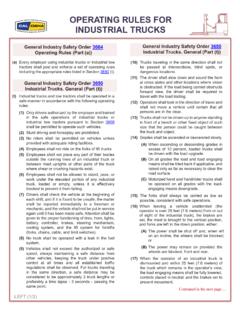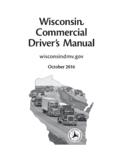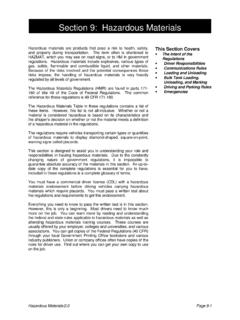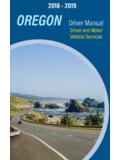Transcription of INDG379 - Health and safety in road haulage - HSE
1 Health and safety in road haulage INTRODUCTION IS THERE A PROBLEM? MANAGING Health AND safety distribution, or specialised haulage such as car transport, bulk materials and bulk the day-to-day activities of the job. haulage and distribution, especially those running small and medium-sized Do you employ people in general haulage and warehousing, wholesale and retail liquids? Each of these may have particular hazards but in every industry where deliveries are made drivers are exposed to significant hazards arising simply from The information in this leaflet is one step towards helping all employers in road businesses, do a better job of ensuring their employees Health and safety . Although it draws on information from the haulage and distribution industry, almost everything here will apply to every operator of commercial vehicles.
2 Over the last five years, accident reports sent to HSE and local authorities show that nearly 60 employees were killed and 5000 seriously injured in haulage and distribution - simply doing their job. Another 23 000 suffered injuries severe enough to keep them off work more than three days. These figures take no account of work-related ill Health , for example from bad backs or stress. This represents a higher rate of accidents to employees than either construction or agriculture, both widely regarded as hazardous industries. Health and safety is seen by many people as so much paperwork, red tape, expense and boring rules and regulations that are difficult to understand and stop you running your business easily.
3 Even if you don t think this way, many people in business believe that because they have had few or no accidents all that is needed is basic common sense and 2 that, in any case, most common accidents these days are unavoidable. Relying on people to use their common sense works fine until something does go wrong. When that means someone gets killed or seriously injured, it can suddenly look a bit of an inadequate approach. Too many employers live to regret not taking Health and safety more seriously before an accident, rather than after one of their employees has been badly injured at work. Controlling Health and safety risks is not that difficult. It can be achieved with a little effort, needn t cost a lot and doing it right can make good business sense.
4 If nothing else, there can be benefits from reduced claims for compensation and lower insurance premiums. WHERE TO START Understanding the sorts of things that result in injury and ill Health can help you recognise the activities most likely to lead to harm. By concentrating on these initially, rather than feeling overwhelmed by the maze of laws, practical steps can be taken to put controls in place. If you follow these you will find you are also well on the way to complying with the law. Deaths at work Almost all deaths arise from just four kinds of accident, most often during loading and unloading or maintenance of vehicles: being struck by a moving vehicle; falling loads; falls from vehicles; collapsing or overturning vehicles.
5 Issues such as use of handbrakes, safe positioning of drivers during loading and unloading with fork-lift trucks, propping of vehicles during repair work and climbing up on vehicles have to be tackled. 3 Major injuries Again, most injuries (more than seven out of ten) are due to just four causes: slips and trips; being struck by moving or falling objects; falls from less than 2 m; and manual handling. Most of these happen to drivers during loading and unloading, though many slips occur during other work. other reportable injuries Manual handling and slips and trips account for two-thirds of other reportable injuries. Addressing these two areas clearly has the greatest potential for reducing the number of such injuries each year.
6 other issues There are other subjects to consider apart from those causing most of the accidents, such as workshop safety , display screen equipment and maintenance of plant and machinery. While these cannot be ignored, they do not contribute to the bulk of accidents and attention should initially be mainly focussed on the areas actually causing most harm if the overall picture is to be improved. WHAT YOU NEED TO DO Many of these accidents could be prevented by simply examining what actually goes on in your business, removing and controlling hazards as far as possible and taking the necessary managerial and supervisory steps to make sure what is supposed to happen does happen. This means looking at what people do at work as well as finding out what controls are needed.
7 The process can be broken down into a number of steps to help translate theory into practice. This is basically all risk assessment and 4 managing safety are about - no more than a structured approach to solving a problem and controlling risk. Do not be put off by the language. A hazard is simply something that can cause harm. Risk is the chance of anyone suffering harm from a hazard. For example, a slippery path is a hazard. The more slippery it is and the more people who walk along it, the greater the risk of someone falling and being injured. You should focus your efforts on practical control and improvements where needed, not on lots of paperwork or forms for their own sake. Simple records of what you have done can help but remember that if risks are not controlled and things do go wrong, paper alone will not be of any value.
8 ORGANISATION You first need someone who is actually going to do this work. It need not be a legal or Health and safety specialist. An appreciation of what happens, and what hazards and risks there are in your business, is essential. Information on the level of practical control needed is also important. Once you or your nominated person has got all this clear, it helps to rank any problems in priority order for action, depending on the likely chance of something going wrong and how serious it may be if it did. A plan setting out what needs to be done can make the task less daunting and provides a starting point for action rather than letting things drift. Someone with enough authority should be responsible for the plan and checking that it is taken forward.
9 Checks are also needed to ensure that any precautions or procedures actually work and are used. 5 WHERE TO GET INFORMATION ON RISKS AND CONTROLS A great deal of written guidance is available from HSE. This has been produced to help employers and employees reduce accidents and ill Health at work. The Further reading section contains details of some titles that may be useful. The HSE Infoline is a mine of useful information. It is run by independent contractors on behalf of HSE, which reassures many people who are hesitant about approaching HSE for advice directly. There is also the HSE website (please see Further information for details), which has a haulage -specific portal that will be developed over time.
10 Members will find the Freight Transport Association Yearbook and the road haulage Association Handbook contain useful summaries of legal requirements and practical advice. Trade unions produce drivers handbooks that are also helpful. Looking at your own company accident records and near-miss reports (if recorded) can be valuable, while simply speaking to employees and looking at the work that goes on can often be the best source of information. Remember there are legal duties to consult employees or their representatives. Many employers have found that involving employees in this way - to eliminate or control risks has been invaluable. Every company will be different but the following checklist of general topics indicates the sorts of things you should be concerned about.

















